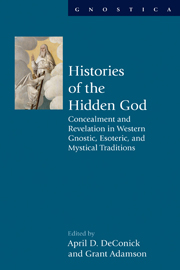 Histories of the Hidden God
Histories of the Hidden God from Part I - Concealment of the Hidden God
While God is always a more or less hidden presence in monotheistic traditions, nevertheless in a Christian context it is fundamental that the incarnation of Christ mediates this hiddenness. Both figuring and operating God's intent for humanity, Christ is God made visible. The body of Christ is memorialized in the Eucharist and the events of his human life structure the main feast days of the Church – events that help to keep God present in the lives of practicing Christians, despite the ongoing hiddenness of God's true nature (understood as a product of the embodied human separation from the divine).
It thus creates a particularly interesting enigma when, in a work designed to shadow the Christian dispensation, it is Christ himself that goes missing. My analysis here will concern the manner in which God's body is hidden in just such a work: a twelfth-century Latin cosmological fable, the Anticlaudianus of Alan of Lille, alternately titled The Good and Perfect Man. Written in the 1180s, the Anticlaudianus in some respects seems to be a repositioning of an ethical system, suitable for the fallen world, on top of the Neoplatonic cosmology which everywhere imbues Alan's writing. The story of the Anticlaudianus is clearly redemptive. Yet the idea of redemption is complicated by the fact that, although the action clearly takes place after Christ's incarnation, the agent of redemption does not appear to be Christ himself (who is mentioned only in passing), but instead another man, a New Man, whose creation is a project instigated by Nature.
To save this book to your Kindle, first ensure [email protected] is added to your Approved Personal Document E-mail List under your Personal Document Settings on the Manage Your Content and Devices page of your Amazon account. Then enter the ‘name’ part of your Kindle email address below. Find out more about saving to your Kindle.
Note you can select to save to either the @free.kindle.com or @kindle.com variations. ‘@free.kindle.com’ emails are free but can only be saved to your device when it is connected to wi-fi. ‘@kindle.com’ emails can be delivered even when you are not connected to wi-fi, but note that service fees apply.
Find out more about the Kindle Personal Document Service.
To save content items to your account, please confirm that you agree to abide by our usage policies. If this is the first time you use this feature, you will be asked to authorise Cambridge Core to connect with your account. Find out more about saving content to Dropbox.
To save content items to your account, please confirm that you agree to abide by our usage policies. If this is the first time you use this feature, you will be asked to authorise Cambridge Core to connect with your account. Find out more about saving content to Google Drive.